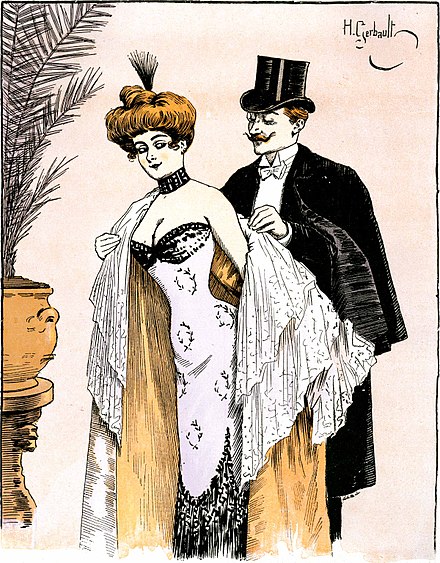Flirting
Flirting or coquetry is a social and sexual behavior involving spoken or written communication, as well as body language, by one person to another, either to suggest interest in a deeper relationship with the other person, or if done playfully, for amusement.
Flirting usually involves speaking and behaving in a way that suggests a mildly greater intimacy than the actual relationship between the parties would justify, though within the rules of social etiquette, which generally disapproves of a direct expression of sexual interest in the given setting. This may be accomplished by communicating a sense of playfulness or irony. Double entendres (where one meaning is more formally appropriate, and another more suggestive) may be used. Body language can include flicking the hair, eye contact, brief touching, open stances, proximity, and other gestures. Flirting may be done in an under-exaggerated, shy or frivolous style. Vocal communication of interest can include, for example,
Flirting behavior varies across cultures due to different modes of social etiquette, such as how closely people should stand (proxemics), how long to hold eye contact, how much touching is appropriate and so forth.[1] Nonetheless, some behaviors may be more universal. For example, ethologist Irenäus Eibl-Eibesfeldt found that in places as different as Africa and North America, women exhibit similar flirting behavior, such as a prolonged stare followed by a nonchalant break of gaze along with a little smile.[citation needed]
The origin of the word flirt is obscure. The Oxford English Dictionary (first edition) associates it with such onomatopoeic words as flit and flick, emphasizing a lack of seriousness; on the other hand, it has been attributed to the old French conter fleurette, which means "to (try to) seduce" by the dropping of flower petals, that is, "to speak sweet nothings". While old-fashioned, this expression is still used in French, often mockingly, but the English gallicism to flirt has made its way and has now become an anglicism.[2]
The word fleurette was used in the 16th century in some sonnets,[3] and some other texts.[4][5][6] The French word fleurette (small flower), and the language of old south France word flouretas (from the Latin flora (for flower)), are related to some little says where flowers are both at the same time a pretext and the comparison terms. In southern France, some usage were yet used in 1484,[7][8]In French, some other words more or less related are derived from the word fleur: for instance effleurer (English: lightly touch) from 13th century esflourée; déflorer (English: deflower) from 13th century desflorer or (fleuret (English Foil) 18th century.
The association of flowers, spring, youth, and women is not modern and were yet considered in ancient culture, such as the Chloris in ancient Greece, or Flora (deity) in the ancient Roman Empire, including Floralia festival, and in other older poems, such as the Song of Songs.[9][10]



